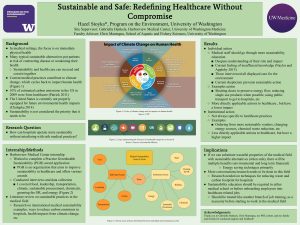Sustainable and Safe: Redefining Healthcare without Compromise
Medical professionals take an oath to put forward efforts to better the care of patients, while simultaneously participating in an industry that emits high levels of greenhouse gas emissions. These emissions cause various adverse health effects, combatting the very promise they are committing to. This hypocrisy was brought to my attention during an interview I conducted last quarter through my internship. At Harborview Medical Center, I learned about the ways in which hospitals are contributing to greenhouse gases. My job was to work with my supervisor to complete an application for a sustainability award (Practice Greenhealth Award) given to hospitals operating in a more sustainable manner. My work was done through data collection, primarily with interviews. While completing this, we looked at eleven areas – buildings, chemicals, climate, energy, leadership, greening the operating room, sustainable procurement, transportation, waste, and water. The goal through my internship and personal research was to determine different ways that the medical field can be simultaneously beneficial to the planet and the people of the planet. Through my efforts I have found that teaching sustainability through the medical curriculum, receiving patient input, and focusing on sustainable resources are some of the many methods that we can use to reduce the carbon footprint of the large contributor that is the medical field. With these strategies, more hospitals can put forth their best efforts to align with sustainability. Medical health and environmental health can exist mutually and one does not need to decrease for the benefit of the other.
